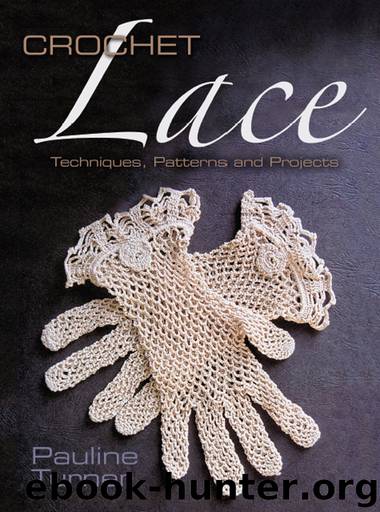Crochet Lace by Pauline Turner

Author:Pauline Turner [Pauline Turner]
Language: eng
Format: epub
Publisher: Dover Publications
Published: 2015-09-04T04:00:00+00:00
The finished, framed flower motifs. Top: iris, left: violet, right: daisy.
Chapter Four
Joining Motifs
Joining Motifs
When crochet was still a new medium, those venturing into it wanted to keep the look of the lace they were copying. This frequently meant that medallions would be connected in rows and the space left in the center of four circular motifs would have a small design incorporated later as a filler.
When connecting motifs in rows, the last round of a motif was worked so that some part of it could be divided to link into the previous motif. This avoided what might have been an obvious, ugly join and it reduced the number of ends that needed to be hidden inside the stitches. (Remember when working with thread that it is more difficult to hide the ends than when working the same item in yarn.)
Modern Methods
There are a variety of ways to connect motifs, but whichever you choose, make sure it joins the motifs as discreetly as possible. Select a method suitable for the shape of the motif and the finished article, bearing in mind what the finished item will be. For instance, if you are making a doily to go under a plant on an occasional table, it would be silly to connect the motifs in such a way that the most attractive part of the design is under the plant.
As with all good design, first select a suitable yarn for the purpose. For example, if vests or jackets are made with fibers that break easily, then it is possible that the garment may catch on a door handle and tear; this would not only disappoint the wearer but destroy hours of work. Next, select a motif that will fit the visual idea and its use. Finally, choose the joining method that you think is best for the motifs. For example, circular motifs frequently require an additional filler, depending on how you intend to place the circles against each other, while squares rarely require them but occasionally need half squares or triangles to make the edges either decorative or straight.
Joining Options
Sewing motifs together should be the last resort simply because of the nature of crochet stitches. Crochet stitches have their own elasticity and move in a way only crochet can, which is definitely not in the same way as knitted or woven fabrics, so when you sew crocheted motifs together you end up with stitches in a rigid and unnatural state. During wear or use, any movement that the crochet may wish to make becomes impossible because of the static nature of the sewn stitches. There are ways to make sewing stitches less immobile, but often these are unsuitable for joining crochet motifs together anyway.
Squares or Octagons with a Solid Edge
Crab stitch: One of the most interesting ways to connect squares or octagons is to crab stitch them together on the right side of the work, particularly if the last round of either of these two shapes is the same color on every motif.
Download
This site does not store any files on its server. We only index and link to content provided by other sites. Please contact the content providers to delete copyright contents if any and email us, we'll remove relevant links or contents immediately.
On Writing A Memoir of the Craft by Stephen King(4667)
The Doodle Revolution by Sunni Brown(4506)
A Simplified Life by Emily Ley(3971)
Mummy Knew by Lisa James(3522)
Marijuana Grower's Handbook by Ed Rosenthal(3514)
Better Homes and Gardens New Cookbook by Better Homes & Gardens(3372)
Paper Parties by Erin Hung(3309)
Figure Drawing for Artists by Steve Huston(3273)
Draw Your Day by Samantha Dion Baker(3128)
The Genius of Japanese Carpentry by Azby Brown(3041)
Japanese Design by Patricia J. Graham(3003)
The Code Book by Simon Singh(2859)
Lions and Lace by Meagan Mckinney(2848)
Dangerous Girls by Haas Abigail(2841)
The Curated Closet by Anuschka Rees(2805)
How to Make Your Own Soap by Sally Hornsey(2743)
The Checklist Manifesto by Atul Gawande(2660)
The Wardrobe Wakeup by Lois Joy Johnson(2638)
Zero to Make by David Lang(2629)
